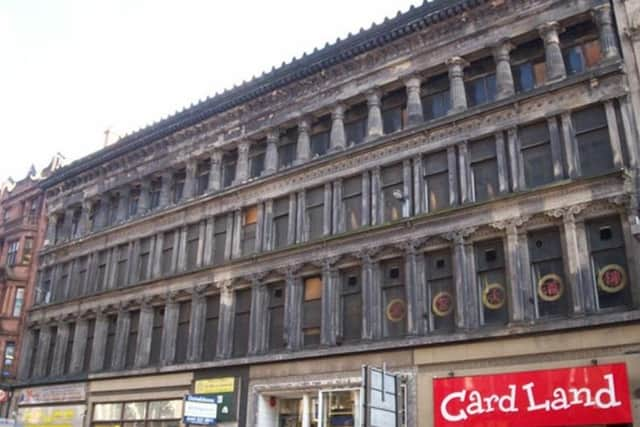Why is there always scaffolding on Union Street? Egyptian halls funding development explained
and live on Freeview channel 276
Why is there scaffolding on Union Street?
The scaffolding on Union Street has been up since 2009, meaning the youngest generation of Glaswegians haven’t seen the real facade of the Egyptian Halls.
No work is being done within Egyptian Halls, apart from the bare minimum to stop the building from falling in on itself, meaning the scaffolding is just supporting the building.
Advertisement
Hide AdAdvertisement
Hide AdOwners, Union Street Developments, refuse to invest further into the building without public funding, The council haven’t extended any such funds for restoration - but also haven’t issued an enforced repair order or compulsory purchase.
The scaffolding originally plastered with huge advertisements for products like Google phones, until Glasgow City Council intervened stating it: “constitutes excessive advertising, which is out-of-scale, over dominant and out-of-keeping with the setting of a Category A listed building.”
Moving forward, from 2018 the scaffolding was adorned with a fake frontage in a reproduction of the real face of the building, which crumbles behind it. The developers said the scaffolding is ‘currently supporting the façade of the building which is in a serious state of disrepair.’
The scaffolding is also used to fix a shroud around the building - keeping the building safe from wind and preventing water from getting into the run-down site.
Advertisement
Hide AdAdvertisement
Hide AdUnion Street Developments have said on several occasions that if they don’t receive funding from the council to restore the historic site, they may be forced to demolish the building. The site remains in scaffold limbo to this day.
What are the Egyptian Halls?
Designed by Glasgow’s own architect, Alexander ‘Greek’ Thomson, the Egyptian Halls are a category A-listed building and have been empty for more than 40 years.
It was originally a commercial building, which due to its city centre location, drew in crowds in the thousands in its day. The building is more than 150-years-old and despite being more classical greek in design, it was named the Egyptian Halls.
The halls were one of the Glaswegian architect’s proudest works, and contained a lecture room, bazaar, and a large central hall where displays of paintings and antiquities were staged, including the display of the complete Egyptian tomb of Thebes.
Advertisement
Hide AdAdvertisement
Hide AdThe upper floors and ground floor are now owned by separate companies – Union Street Developments and Union Street Properties – both run by Dundee businessman Derek Souter, alongside his brother Duncan and Kelvin Kerr.
They bought the entire building in the summer of 2008, but other than work to prevent further decay, little work has been done on the building.
Europa Nostra, a pan-Europan heritage organisation, shortlisted the building for its seven ‘Most Endangered’ programme - a campaign to push for repairs for at-risk historic landmarks.


When will the scaffolding on Union Street come down?
Recent years have seen more interest in investment in the halls, including bids to acquire ownership to undertake a full restoration programme.
Advertisement
Hide AdAdvertisement
Hide AdThe Scottish Civic Trust, which was established in May 2021 - with trustees like Paul Sweeney MSP, John Nicolson MP, and Murray Grigor - want to take on the task of saving the building, and have been backed by community groups like Save Egyptian Halls
Towards the end of last month, September 2022, the working group secured funding from Glasgow City Heritage Trust and the Architectural Heritage Fund to begin to develop a plan for the building’s future.
Organisers first need to figure out what to do with the building before any restoration work can begin, and with its massive open-plan nature it could fill a wide range of purposes. Chair of the working group, Fiona Sinclair said: “There is no shortage of ideas for the re-purposing of this iconic, internationally-significant building, but the key is to deliver an end use that is sustainable, both in business as well as energy terms.
“As well as being architecturally exceptional, Egyptian Halls is importantly located next to one of the city’s principal transport hubs, and surely has a role to play in addressing the climate crisis.”
So while plans for the restoration of the building are further along than they’ve been in 20 years, there is still no concrete date set for the beginning of work, let alone a date for the completion.
Comment Guidelines
National World encourages reader discussion on our stories. User feedback, insights and back-and-forth exchanges add a rich layer of context to reporting. Please review our Community Guidelines before commenting.
